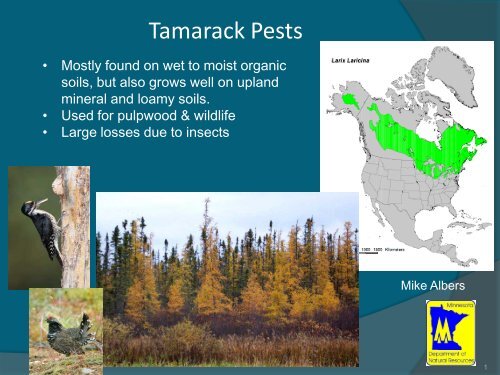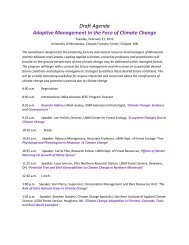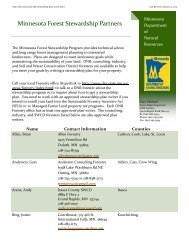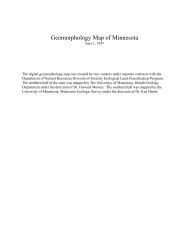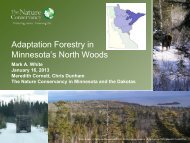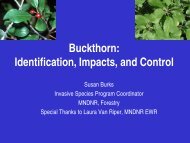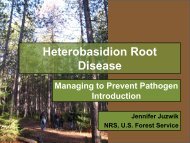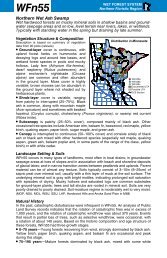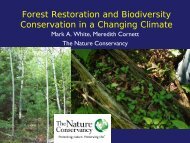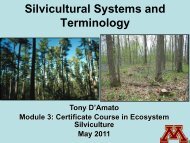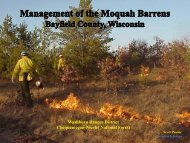Tamarack Pests
Tamarack Pests
Tamarack Pests
You also want an ePaper? Increase the reach of your titles
YUMPU automatically turns print PDFs into web optimized ePapers that Google loves.
<strong>Tamarack</strong> <strong>Pests</strong><br />
• Mostly found on wet to moist organic<br />
soils, but also grows well on upland<br />
mineral and loamy soils.<br />
• Used for pulpwood & wildlife<br />
• Large losses due to insects<br />
Mike Albers<br />
1
<strong>Tamarack</strong><br />
Pioneer species –only deciduous conifer in MN<br />
very intolerant to shade<br />
one of the fastest growing conifers<br />
Approximately 1,000,000 acres of tamarack covertype in MN<br />
Over 50% of tamarack is on state lands<br />
<strong>Tamarack</strong> is under utilized<br />
2007 estimates - sustainable harvest = 115,000 cords/yr<br />
- actual harvest level 53,000 cords<br />
<strong>Tamarack</strong> historically – public land survey-most abundant tree in MN<br />
– now 6 th or 7th<br />
Large losses due to I&D problems<br />
I&D<br />
larch sawfly<br />
decays, root rots<br />
blue stain fungi<br />
larch casebearer<br />
eastern larch beetle<br />
2
Larch sawfly<br />
Found around the world where larch grows.<br />
Historically has caused continent wide outbreaks with high levels of mortality<br />
Is it native or not? Coulson&Witter = 4 strains in NA - 2 strains native and 2 non-native.<br />
One generation per year.<br />
Larvae defoliates tamarack. Tree mortality after 7 or more years of defoliation.<br />
3
History of Larch sawfly<br />
outbreaks and parasites<br />
Defoliation east of Grand Rapids 1997<br />
Wide spread outbreaks and mortality in North America from 1880s - 1970’s<br />
First record in MN in 1909. (tree ring analysis – defoliation events in 1840’s &1880’s)<br />
MN outbreak 1910 -1926 = 1 billion board feet killed.<br />
Parasite from Britain released in Manitoba in 1913. Spread through NA.<br />
Fewer outbreaks and less mortality 1930’s and 1940’s<br />
Larch sawfly became immune to this parasite by the late 1940’s.<br />
MN outbreak late 1940s -1970’s reported that 40% of tamarack in MN killed.<br />
1960s a Bavarian strain of the parasite plus another ichneumon released Manitoba.<br />
In 1971 & 72 -released in northern MN. (UMN & DNR)<br />
Since then short outbreaks with little mortality.<br />
Last defoliation I saw in MN was ‘97. App 10 acres.<br />
5
Stem decays<br />
Ontario 1950’s<br />
Phellinus pini – red ring rot, red heart<br />
white pocket decay<br />
Fomitopsis officinalis<br />
brown trunk rot<br />
6
Root and butt rots<br />
Armillaria root rot<br />
Tomentosus root rot<br />
red butt rot<br />
7
Fungi Isolated from Eastern Larch Beetles in<br />
Minnesota<br />
Ophiostoma floccosum<br />
Ophiostoma picea<br />
Ophiostoma ips<br />
Leptographium abietinum<br />
Pesotum fragrans<br />
Phlebiopsis gigantea<br />
Pichia scolyti<br />
<br />
<br />
* based on DNA sequencing<br />
Work by Andy Graves -UC Davis, Robert Blanchette-U of MN, Tom Harrington-<br />
Iowa State<br />
Blue stain fungi – degrade wood quality, may help kill trees by plugging vessels,<br />
may be food source for beetles 8
Larch casebearer<br />
Exotic needle miner- first found in NA in 1886, Lake States 1920’s - larvae eat the inside of the<br />
needle - persistent defoliation by 1930’s led to release of parasites from Europe.<br />
9
Outbreak since 2000<br />
Likely cause stress<br />
but have seen no mortality<br />
to date<br />
Larch casebearer<br />
30000<br />
25000<br />
20000<br />
Acres<br />
15000<br />
10000<br />
5000<br />
0<br />
2005 2006 2007 2008 2009 2010 2011<br />
11,400 ac<br />
in 2011<br />
10
Eastern larch beetle<br />
Dendroctonus simplex<br />
• Native to North America<br />
• Large range throughout Canada<br />
and the United States<br />
• Colonizes eastern larch<br />
(tamarack), Larix laricina<br />
• ‘Secondary’ bark beetle?<br />
(Bark Beetles of Canada and Alaska 1976 – says<br />
ELB is not of economic importance.)<br />
Seybold et al. 2002<br />
11
Larch beetle mortality 2000 through 2011<br />
Mortality on 123,000 acres<br />
<strong>Tamarack</strong> covertype = 1,000,000 acres<br />
Mortality = 12% of covertype<br />
12
August 2011<br />
13
August 2011<br />
14
Acres<br />
20000<br />
18000<br />
16000<br />
14000<br />
12000<br />
10000<br />
8000<br />
6000<br />
4000<br />
2000<br />
0<br />
New acres of tamarack mortality caused<br />
by larch beetle, 2000 to 2011<br />
2000 2001 2002 2003 2004 2005 2006 2007 2008 2009 2010 2011<br />
140000<br />
120000<br />
100000<br />
Cumulative acres of tamarack mortality<br />
caused by larch beetle, 2000 to 2011.<br />
Acres<br />
80000<br />
60000<br />
40000<br />
20000<br />
0<br />
2000 2001 2002 2003 2004 2005 2006 2007 2008 2009 2010 2011<br />
15
<strong>Tamarack</strong> mortality due to Eastern larch Beetle 2011<br />
29,000 acres<br />
16
Life-cycle<br />
Callow adult<br />
Brood adult / Mature adult<br />
Eggs<br />
Pupa<br />
Larva (4 instars)<br />
17
Reproductive biology<br />
Brood<br />
1<br />
Summer re-emergence<br />
late June – mid July<br />
Brood<br />
2<br />
mid May – late June<br />
mid July – mid Aug.<br />
Spring emergence<br />
early May – mid June<br />
late June – early Aug.<br />
late July – late Oct.<br />
mid July – mid Aug.<br />
mid Aug. – early Oct.<br />
late Aug – next May<br />
Immature<br />
early Oct. – Dec<br />
Immature<br />
18<br />
Langor 1987a, b
Heavy resin flow<br />
from attacked<br />
trees<br />
Small entrance holes<br />
In July some trees start to show yellowing and browning of needles often on lower part of tree.<br />
50% of trees being attacked show no color change during growing season but are dead next spring. Makes aerial<br />
detection of current year activity difficult.<br />
19
Black backed woodpecker 20
Why is Eastern Larch Beetle causing so much tamarack<br />
mortality?<br />
Warmer winters and longer growing seasons?<br />
Precipitation levels? Drought, high water levels<br />
Stand conditions? Age, stand composition, vigor<br />
Changes in larch beetle behavior? Secondary, primary<br />
Is larch casebearer stressing tamaracks making them susceptible to LB?<br />
21
What is causing the eastern larch beetle outbreak in MN?<br />
Is larch casebearer defoliation predisposing tamarack to attack by larch beetle?<br />
Larch Beetle<br />
2000-2009<br />
Larch Casebearer<br />
2000 - 2009<br />
92,000<br />
acres<br />
mortalti<br />
y from<br />
larch<br />
beetle<br />
92,000 acres<br />
mortality by<br />
larch beetle<br />
47,500 acres<br />
defoliated by<br />
larch<br />
casebearer<br />
By 2000-2009 0nly 4152 acres have had both larch beetle and larch casebearer<br />
= 4.4% of larch beetle mortality<br />
22
Stand conditions<br />
Age and DBH – seems to prefer larger DBH but attacks and kills down to 2”<br />
- seems to attack older larger trees first but found on 40 year old trees<br />
and up<br />
Upland vs lowland- kills trees on upland and lowland sites<br />
Mixed species stands vs pure tamarack stands- ELB doesn’t seem to care<br />
a tamarack is a tamarack<br />
These questions need more research<br />
23
What is causing the eastern larch beetle outbreak in MN?<br />
Is drought or high water predisposing tamarack to attack by LB?<br />
<strong>Tamarack</strong> mortality<br />
became apparent<br />
starting in 2000.<br />
Upland vs lowland<br />
24
Longer growing season – more demand on soil moisture ,<br />
longer growing season for LB to mature<br />
4+ wks<br />
25
Overwintering of ELB<br />
Confusion in the literature<br />
Wood, 1982 – Principal overwintering stage is the adult, also find some larvae.<br />
Werner, 1986- Overwinters as adults beneath bark<br />
Langor & Raske, 1986 – Only adults overwinter. Cold temps kill larvae &<br />
pupae.<br />
In Minnesota based on collections<br />
from above the snow line, made in<br />
late winter of 2002 – 2009 adults and<br />
larvae survive.<br />
Are warmer winters allowing more LB to<br />
overwinter resulting in increased tamarack<br />
mortality? 26
Procedure for measuring<br />
supercooling points of bark beetles<br />
<br />
LB are freeze intolerant<br />
have to super cool when<br />
temps are below freezing.<br />
Dr Rob Venette<br />
NRS, St Paul, MN<br />
Abby Walter<br />
U of MN<br />
-80.0°C<br />
27
Seasonal changes in mean supercooling point (±SEM) of<br />
larval and adult Dendroctonus simplex.<br />
ELB are freeze intolerant<br />
-16C<br />
(+3.2F)<br />
-17.5 (+1.4F)<br />
-43F<br />
-49C (-56F)<br />
-56F<br />
Rob Venette<br />
NRS, MN<br />
-42C (-43F)<br />
Abby Walter<br />
U of MN<br />
28
Predicted impacts of winter low temperatures on Eastern larch<br />
beetle populations<br />
Larvae are extremely<br />
cold-tolerant –most<br />
survive winters.<br />
Low winter<br />
temperatures<br />
increased 0.25C /yr<br />
1964-2004.<br />
Adult survival has<br />
increased 0.7% /yr<br />
from 1964-2004.<br />
Greater overwintering<br />
success by ELB and<br />
may lead to increased<br />
tree mortality<br />
Minimum annual temperature (°C)<br />
-24<br />
-26<br />
-28<br />
-30<br />
-32<br />
-34<br />
-36<br />
-38<br />
-40<br />
-42<br />
-44<br />
-46<br />
0.0<br />
1960 1965 1970 1975 1980 1985 1990 1995 2000 2005<br />
Winter temperatures for Isle, MN<br />
Year<br />
Larval survival<br />
Adult survival<br />
just south of Mille Lacs Lake<br />
1.0 100%<br />
0.8 80%<br />
0.6 60%<br />
0.4 40%<br />
0.2 20%<br />
From -Proceedings Society of American foresters, 2008, Reno, Nevada<br />
In Press- Forrest Health Monitoring 2008, National Report 29<br />
8<br />
0<br />
%<br />
Proportionate survival (predicted)
Currently…….<br />
I still do not know what factor or factors might be involved in the<br />
eastern larch beetle outbreak in Minnesota .<br />
It appears possible that warmer winter temperatures and maybe<br />
longer growing season may be a factor.<br />
And, help from the U of MN is on the way.<br />
30
Current Research on ELB in MN<br />
• Fraser McKee, PhD student<br />
• Advisor -Dr. Brian Aukema U of MN Dept of Entomology<br />
• First field work completed last summer. Just received<br />
funding for 3 more years. Research will be mostly near<br />
Baudette.<br />
Committee members<br />
• Drs. Tony D’Amato, Steve Kells, Rob Venette<br />
MN Department of Natural Resources<br />
• Val Cervenka, Jana Albers, Mike Albers, Becky Lein,<br />
Gretchen Mehmel, Mike Hoppus<br />
31
Research Background<br />
<br />
Only two major studies on the<br />
biology of the eastern larch beetle<br />
• Alaska (Werner 1986)<br />
• Newfoundland, Canada (Langor &<br />
Raske 1987a,b, 1988)<br />
<br />
<br />
No comprehensive case-study for<br />
the Midwest region<br />
Field observations of insect biology<br />
in MN differ markedly from the<br />
published literature<br />
Seybold et al. 2002<br />
?<br />
32
Research<br />
Studies of insect biology<br />
• Understand the contribution of each larval brood to the<br />
reproductive population of beetles<br />
• More accurately define the over-wintering biology and<br />
ability of the beetles to engage in host attack and<br />
reproduction earlier in the year<br />
33
Research<br />
Studies of insect biology<br />
• Understand the contribution of each larval brood to the<br />
reproductive population of beetles<br />
• More accurately define the over-wintering biology and<br />
ability of the beetles to engage in host attack and<br />
reproduction earlier in the year<br />
Landscape-level analysis of the outbreak<br />
• Identify the climatic variables potentially driving the current<br />
outbreak<br />
34
Research<br />
Studies of insect biology<br />
• Understand the contribution of each larval brood to the<br />
reproductive population of beetles<br />
• More accurately define the over-wintering behavior and<br />
ability of the beetles to engage in host attack and<br />
reproduction earlier in the year<br />
Landscape-level analysis of the outbreak<br />
• Identify the climatic variables potentially driving the current<br />
outbreak<br />
Stand-level analysis of tamarack growth rates and<br />
beetle host selection<br />
• Determine if a widespread decline in tamarack growth is<br />
occurring in Minnesota<br />
• Provide information on how beetles are interacting with the<br />
tamaracks present on the current landscape<br />
35
Research<br />
The influence of tamarack quality on host<br />
selection and subsequent reproductive<br />
success<br />
• Provide information on beetle-host interactions at a<br />
fine scale<br />
• Examine how the health of individual tamaracks<br />
contributes to the reproductive success and<br />
population dynamics of the beetle<br />
36
Questions<br />
37


